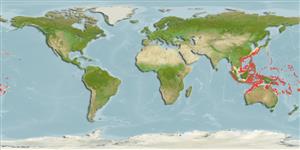>
Eupercaria/misc (Various families in series Eupercaria) >
Lutjanidae (Snappers) > Etelinae
Etymology: Pristipomoides: Greek, pristis = saw + Greek, poma, -atos = cover, operculum + Greek, oides = similar to (Ref. 45335).
More on author: Valenciennes.
Environment: milieu / climate zone / depth range / distribution range
Ecología
marino asociado a arrecife; rango de profundidad 70 - 350 m (Ref. 9821). Tropical; 35°N - 24°S, 98°E - 167°W (Ref. 55)
Indo-Pacific: East Africa to the Society Islands, north to southern Japan, south to New Caledonia.
Tamaño / Peso / Age
Maturity: Lm ? range ? - ? cm
Max length : 40.0 cm SL macho / no sexado; (Ref. 9821); common length : 25.0 cm SL macho / no sexado; (Ref. 9821)
Espinas dorsales (total) : 10; Radios blandos dorsales (total) : 11; Espinas anales: 3; Radios blandos anales: 8. Interorbital space slightly convex. Preorbital depth 7.0 to 8.0 times in head length. Pectoral fins long, reaching level of anus. Scale rows on back parallel to lateral line. The upper part of the head reddish; the back mainly yellow; the sides and belly silvery, sometimes pinkish; body with very many bright blue spots and vermiculations. The dorsal and caudal fins yellowish.
Adults are found over rocky bottoms. They feed on small fishes, crustaceans and squids.
Life cycle and mating behavior
Madurez | Reproducción | Puesta | Huevos | Fecundidad | Larva
Allen, G.R., 1985. FAO Species Catalogue. Vol. 6. Snappers of the world. An annotated and illustrated catalogue of lutjanid species known to date. FAO Fish. Synop. 125(6):208 p. Rome: FAO. (Ref. 55)
IUCN Red List Status (Ref. 130435: Version 2024-2)
Threat to humans
Harmless
Human uses
Pesquerías: escaso valor comercial
Herramientas
Special reports
Download XML
Fuentes de Internet
Estimates based on models
Preferred temperature (Ref.
123201): 15.2 - 26.2, mean 20.4 °C (based on 252 cells).
Phylogenetic diversity index (Ref.
82804): PD
50 = 0.5005 [Uniqueness, from 0.5 = low to 2.0 = high].
Bayesian length-weight: a=0.01514 (0.00897 - 0.02555), b=3.00 (2.86 - 3.14), in cm total length, based on LWR estimates for this species & Genus-body shape (Ref.
93245).
Nivel trófico (Ref.
69278): 4.2 ±0.57 se; based on food items.
Resiliencia (Ref.
120179): Medio, población duplicada en un tiempo mínimo de 1.4-4.4 años (Preliminary K or Fecundity.).
Fishing Vulnerability (Ref.
59153): Moderate vulnerability (39 of 100).
Nutrients (Ref.
124155): Calcium = 40.7 [22.0, 71.5] mg/100g; Iron = 0.638 [0.331, 1.057] mg/100g; Protein = 18.9 [17.0, 20.7] %; Omega3 = 0.184 [0.114, 0.294] g/100g; Selenium = 46.9 [27.3, 85.5] μg/100g; VitaminA = 116 [42, 380] μg/100g; Zinc = 0.863 [0.599, 1.221] mg/100g (wet weight);
